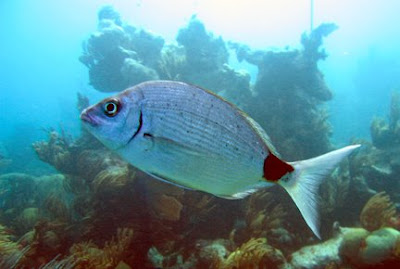BREAM?!? Why BREAM?

One may wonder why we would choose to name ourselves after the Bermuda Bream, considering some of the other, less pleasant names we Bermudians call the fish.
Well, there was the pragmatic reason that "Bream" started with a B - so we could start our name with "Bermuda"...
However, another draw was that the Bermuda Bream is actually an endemic fish, meaning it is a species found in Bermuda and no where else. Yep - our bream are ours alone, at least according to Caldwell (1965), who first stated this assertion. It' species name is Diplodus bermudensis.
That said, there are sister species found across the Atlantic, including one in the Mediterranean called the White Bream (Diplodus sargus sargus) which looks remarkably like our guy. I took a photo of the specimen below in the Monaco Aquarium a few weeks ago.

There are also bream over in the US and Caribbean, and down to South America, but with the much nicer name of Silver Porgy.
Not surprisingly there is some controversy about whether our local species is an endemic or not. In the book "Fishes of Bermuda", Smith-Vaniz et al. mention that there is still a need to fully compare the Bermuda fish with the similar fish from the rest of the Western Atlantic.
Despite the local reputation that bream are a bottom-feeding fish and therefore of low food quality, in many parts of the world similar species are actually targeted, although truthfully this may be because there are no better fish left to eat. There have even been attempts at rearing other bream using aquaculture techniques. Certainly some people are eating bream in Bermuda. Also, the recent study on mercury in Bermuda fish found that mercury levels are low in fish lower on the trophic ladder, which bream are, so perhaps those eating bream locally are on to something!
Perhaps we could re-market the poor bream by calling it a Bermuda Porgy, although then again that would mean we here at BREAM would lose our spiffy mascot.
Reference: Caldwell DK (1965) A new sparid fish of the genus Diplodus from Bermuda. Fieldiana Zoology 44:217-225.

Comments